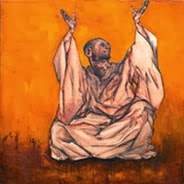 [[Dear Sister Laurel,
[[Dear Sister Laurel,
How is it that hermits reflect the centrality of Eucharist in their spiritual lives if they do not attend Mass daily? I heard you remark in another context that you didn't attend Mass if solitude required otherwise. My understanding is that religious are required canonically to attend Mass daily if that is possible, and you yourself say on this blog that Eucharist is the center of everything that happens at your hermitage. So, how is it you can skip Mass just because it is more convenient to remain in solitude and still claim the title Sister and assert how central Eucharist is in your life? My other question is how do you receive Communion if there is no one there but yourself? Isn't self-communication forbidden to Catholics?]]
These topics, as you apparently are aware, came up on the Catholic Hermits list. One person there argued that hermits, like anyone else, should get to Mass as often as possible (daily!), and should not miss simply because it was "inconvenient" to one's solitude. Since, they argued, religious are required to participate at Mass in this way it makes sense that diocesan hermits are also so required. Others have argued that in today's world of easy transportation and numerous parishes people should be able to get to Mass daily one way or another and that hermits certainly should do so. Some know hermits who attend the parish Mass each day, or at least most every day and argue on that basis. My own argument was that fidelity to solitude sometimes meant not getting to daily Mass. I believe it is possible to develop a strong Eucharistic spirituality in solitude even without getting to Mass daily and that is what I want to look at in this post.
On the Place of Solitude in the Hermit's Life
However, before I say more in response to your question I need to clarify one critical point. Your comments include a misconstrual of what I said, and a misunderstanding regarding the nature of eremitical solitude. Namely, hermits do not skip Mass merely because it is inconvenient to their solitude; they do so because solitude is their full-time calling and the actual occasion, environment, and resulting quality of whatever union with God is achieved in their life. Solitude is not just a means for the hermit, but a goal as well. In this perspective, solitude (or what Canon 603 refers to as the "silence of solitude") is not a self-indulgent luxury which just happens to provide an environment for other things in the hermit's life (though external silence and physical solitude will certainly serve in this way). It is instead the reality which is achieved together with God when a hermit is faithful to (among other things) long term external silence and solitude. Thus, it is important that the hermit maintain her faithfulness to this long term external silence and solitude. Solitude is, again, both the means to and the goal of the hermit's existence because eremitical solitude itself is a form of communal or ecclesial existence and an expression of union with God and all that is precious to God.
In saying this I mean that the hermit's life is to give witness to the union with God which is achieved in solitude as well as the "silence of solitude" which is an expression and sign of this union, and so, to the redemption of all forms of human isolation, alienation and estrangement achieved therein. They are called to come to wholeness and holiness in solitude and their witness is to the most foundational relationship present in the human being, the relationship with God who is creator and ground of all existence. In other words, although community is important to the hermit, it is primarily the koinonia (communion) of solitude that is their vocation. They are called by God through the agency of his Church to the very rare and paradoxical reality of eremitical solitude --- a form of union with God and others marked by and grounded in aloneness with the Alone. Unless we understand that solitude is not isolation, not alienation, nor a feeble excuse for the misanthrope, and certainly not a luxury for the hermit, we may believe that it conflicts with a truly Eucharistic spirituality. My argument is that it does not and that the way the hermit approaches attendance at Mass is dependent upon this way of seeing things.
Eucharistic Spirituality in General
 When we speak of Eucharistic Spirituality what is it we are talking about then? And for the hermit who claims that the Eucharist is at the heart of everything that happens in the hermitage, what is she really talking about --- especially if the Mass is not (or is rarely) celebrated at the hermitage? Of course it means a spirituality focused on the Eucharist itself and the hermit will usually (not always) reserve Eucharist in her hermitage, pray in the presence of the Eucharist, celebrate Communion services (Liturgies of the Word with Communion), and so forth. But even more than this everything at the hermitage will be geared towards Christ's incarnation climaxed in his cross and resurrection. It seems to me that the focus involves two particular and interrelated processes: first, that, in a dynamic of kenosis or self-emptying, the Word is made flesh, and second, that, in a dynamic of conversion, reconciliation, and transfiguration, flesh (in the Pauline sense) is made Word. Everything that happens is meant to be an occasion of one or both of these and at the center of it all is the Presence of the Risen Christ in Word and Sacrament, reminding, summoning, challenging, nourishing, and consoling.
When we speak of Eucharistic Spirituality what is it we are talking about then? And for the hermit who claims that the Eucharist is at the heart of everything that happens in the hermitage, what is she really talking about --- especially if the Mass is not (or is rarely) celebrated at the hermitage? Of course it means a spirituality focused on the Eucharist itself and the hermit will usually (not always) reserve Eucharist in her hermitage, pray in the presence of the Eucharist, celebrate Communion services (Liturgies of the Word with Communion), and so forth. But even more than this everything at the hermitage will be geared towards Christ's incarnation climaxed in his cross and resurrection. It seems to me that the focus involves two particular and interrelated processes: first, that, in a dynamic of kenosis or self-emptying, the Word is made flesh, and second, that, in a dynamic of conversion, reconciliation, and transfiguration, flesh (in the Pauline sense) is made Word. Everything that happens is meant to be an occasion of one or both of these and at the center of it all is the Presence of the Risen Christ in Word and Sacrament, reminding, summoning, challenging, nourishing, and consoling.
Eucharistic Spirituality, The Word Made Flesh
God has chosen to come to us as a human person. More than that he has chosen to be present in a power perfected in weakness (asthenia). He is present in the unexpected and even the unacceptable place. He enters into sin and death, the truly or definitvely godless realities and transforms them with his presence. In other words he makes what was literally godless into sacraments of his love, his being God for and with others. For me the Eucharist is a symbol of this specific process and presence (and I mean symbol in the most intensive sense as that reality which does not merely stand for something else (that would be a sign or metaphor) but rather as something that participates in the very reality it mediates). While Mass is the place where we literally re-member all of this, where bread and wine are transformed into the Body and Blood of Christ, where the Word of God is proclaimed with power, Eucharistic Spirituality seems to me to be that spirituality where all this is worked out in everyday life so that every meal is holy, every reality is looked at with eyes that can see God's presence there, and where one is nourished, challenged, consoled, etc, with that presence in the unexpected place and way.
Eucharistic spirituality, is a spirituality which is open to God's presence in ordinariness, not only to his presence at Mass or the more exalted moments of prayer, etc, but in the humbleness of human life generally. And for the hermit this means in the solitariness of ordinary life --- for it is in solitude that we are generally weakest, and our brokenness is most clearly revealed. My own focus in the hermitage is the transformation of ordinariness into Sacrament. This is essentially Eucharistic. Everything should serve this. Everything within the hermitage serves the Word becoming flesh, the allowing of God to dwell within, to love, minister to, and to transform with his presence. Everything becomes a matter of dying to self and rising in God, to learning obedience (hearing and responding to the Word of God) in a way which leads to purity of heart. Yes, often (though not always) Eucharist is present in the hermitage, but whether or not it is present it remains the living symbol of what everything in the hermitage can and is meant to be if given over to the purposes of eremitical life. I sincerely believe that if the hermit practices Eucharistic spirituality she recognizes that her hermitage itself is meant to be a tabernacle situated in the midst of her community and that her own life is bread broken and wine poured out for others.
Eucharistic Spirituality, Flesh Made Word
 The second and interrelated process which makes up a genuinely Eucharistic spirituality focuses on what happens to the hermit --- or really, to any Christian for whom Eucharist is central --- namely, that they become a Word Event which embodies and proclaims the Gospel of God in Christ. For the hermitage to become tabernacle, for the hermit to become bread broken and wine poured out for others, the hermit herself must, over time, be transformed and transfigured.
The second and interrelated process which makes up a genuinely Eucharistic spirituality focuses on what happens to the hermit --- or really, to any Christian for whom Eucharist is central --- namely, that they become a Word Event which embodies and proclaims the Gospel of God in Christ. For the hermitage to become tabernacle, for the hermit to become bread broken and wine poured out for others, the hermit herself must, over time, be transformed and transfigured.
Flesh, in the Pauline sense of the term, means the whole person, body and soul, under the sway of sin. It means being a person of divided heart, one who is enmeshed in processes and realities which are resistant to Christ. It means being less than fully human, and in terms of language, it means being distorted forms of language events which are less than a univocal hymn of praise and gratitude --- screams of pain and anguish, lies or hypocritical formulations and identity, utterances (of anger, prejudice, arrogance, indifference, selfishness, etc) which foster division, insecurity, and suffering for others, a noisy or insecure presence which cannot abide silence and is unable to listen or respond lovingly and with compassion --- all are the less than human forms of language event we are, at least at times. These are also examples of what Paul would have termed "flesh" (sarx).
In the power of the Spirit, these can be transformed, transfigured into articulate expressions of Gospel wholeness, joy, peace, hope, and challenge. That which is less than human can become authentically human; sinners are reconciled to become persons who are truly and wholly authored by God. As one steeps oneself in and seriously contends with the Word of God one is transformed into an expression of that Word. In silence and solitude flesh can become Word just as the Word becomes Flesh. All of this is genuinely Eucharistic spirituality I think, and it remains Eucharistic even if the hermit does not celebrate Eucharist with her parish community daily. For the hermit, those privileged celebrations lead back to silence while solitude and the silence of solitude prepare for the hermit's participation at Mass. But they are all part of a single spirituality in which Christ is received as guest and gift and ordinary reality is transformed into an expression of his presence. Such a spirituality is open to anyone who cannot actually get to Mass more than once a week, and sometimes less frequently. It is inspired by the Eucharist and modeled on Eucharistic transformation, life, and hope. In fact, I suspect it may well be an instance of genuinely Eucharistic spirituality our world truly needs.
Hermits and Self-Communication
 Your last question was also raised on the Catholic Hermits list. It is customary that people do not self-commu-nicate and there are very good theological reasons for this, but solitary hermits are an accepted exception. Canonists are apparently clear (according to a clarification offered on the Catholic Hermits list) that this is a unique situation which calls for such an exception to general custom and theological wisdom. It is also, it seems to me, a sign of how truly esteemed and unusual is the hermit vocation for such an exception to be made. The Church allows this exception precisely because of the importance of eremitical solitude lived in the heart of the church. I would argue that eremitical solitude, to whatever extent it is lived authentically, is essentially Eucharistic --- even when the hermit is unable to leave her hermitage to attend Mass --- and is therefore a very good reason for this singular exception to be made.
Your last question was also raised on the Catholic Hermits list. It is customary that people do not self-commu-nicate and there are very good theological reasons for this, but solitary hermits are an accepted exception. Canonists are apparently clear (according to a clarification offered on the Catholic Hermits list) that this is a unique situation which calls for such an exception to general custom and theological wisdom. It is also, it seems to me, a sign of how truly esteemed and unusual is the hermit vocation for such an exception to be made. The Church allows this exception precisely because of the importance of eremitical solitude lived in the heart of the church. I would argue that eremitical solitude, to whatever extent it is lived authentically, is essentially Eucharistic --- even when the hermit is unable to leave her hermitage to attend Mass --- and is therefore a very good reason for this singular exception to be made.
In any case, hermits should certainly be careful of their use of this permission. Their own communions must always be seen as extensions of the parish and/or diocesan liturgy, their hermitages must be understood as tabernacles of Christ's presence, and the silence of solitude must be embraced as a natural expression of communal life and love. While the hermit does not literally receive Eucharist from the hands of another during Communion services in the hermitage, she does receive this Sacrament as a gift of the parish community and so, from their hands. The communal nature of the eremitical life is constantly underscored by the presence of Eucharist in the hermitage, and the quality of being "alone with the Alone" FOR the salvation of the world is underscored in this way as well. Eremitical life is not selfish, not individualistic or privatistic, and emphatically not a matter of merely living alone -- much less doing so in whatever way one likes. The presence of Eucharist both symbolizes and so, reminds and calls us to realize this (make this real) more and more fully everyday. I should note that it is entirely reasonable to expect that should a hermit ever tend to take the Eucharist for granted or become arrogant or simply lax in her praxis and perspective, then, at least for a time, she should forego even the reservation of the Eucharist, and get to Mass more often, until she recovers her proper perspective and devotion.
Summing Things Up
For me the bottom line in all of this is that while the celebration of Eucharist is indeed the source and summit of ecclesial life --- and it certainly is that for the hermit as well --- a truly Eucharistic spirituality does NOT necessarily require that one go to Mass daily. The hermit's life will be imprinted with the cross, be emptied, broken and given to others precisely insofar as she is faithful to eremitical solitude lived in the heart of the Church. She will celebrate every day, and do so with her faith community, even when the demands of solitude mean she cannot be physically present with them at Mass. If this is not the case, then we are implicitly saying to many people who pray, suffer, and love at least as fully and well as do daily Mass participants (or diocesan hermits!) --- but who cannot get to Mass regularly --- that they cannot be said to have or even be able to develop a truly Eucharistic spirituality. I am positive we do not want to do that, wouldn't you agree?
see also: Notes from Stillsong Hermitage: On the Reservation of Eucharist by Hermits

























































